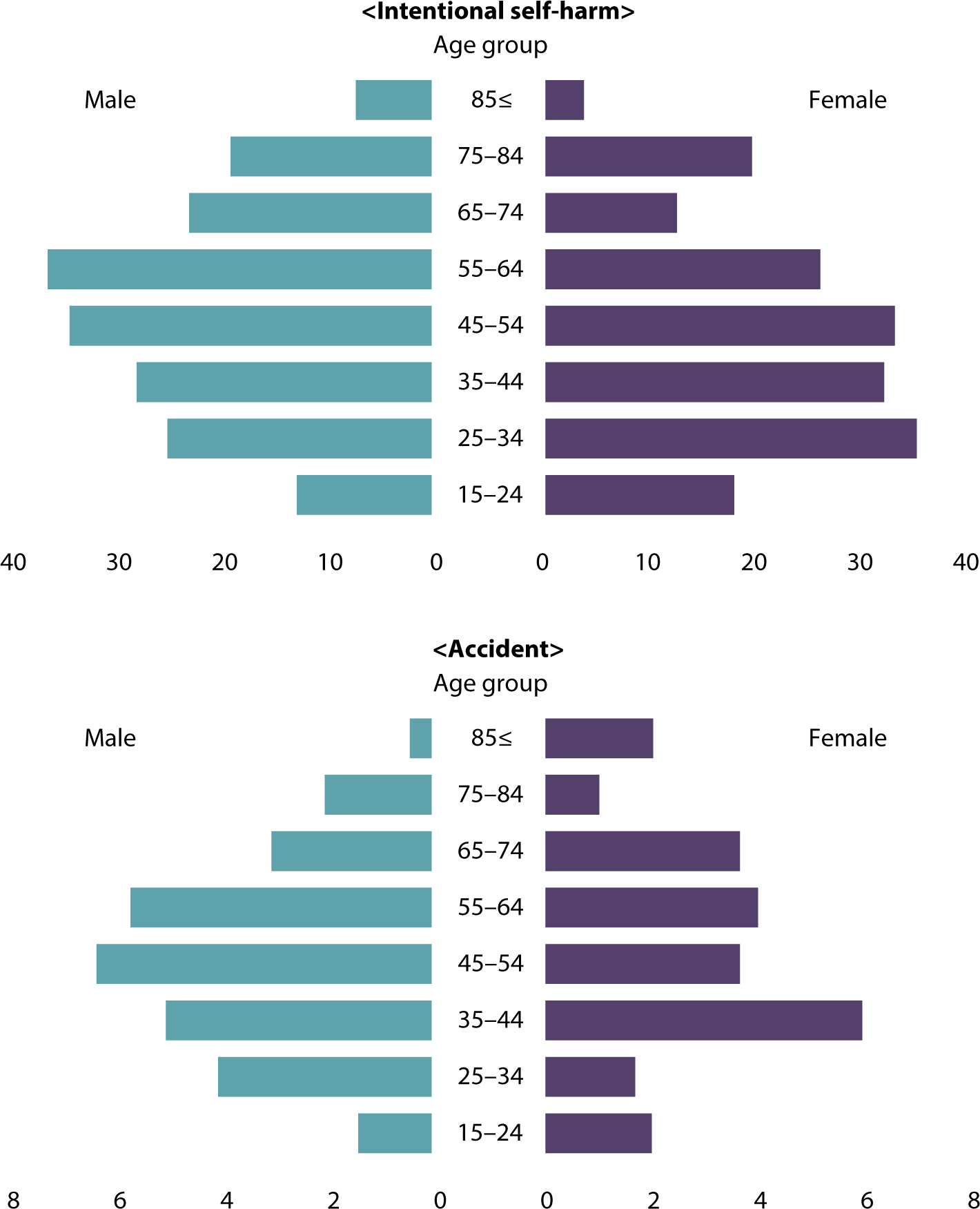Ewha Med J.
2024 Apr;47(2):e27. 10.12771/emj.2024.e27.
Drug-induced death statistics in Korea between 2011 and 2021
- Affiliations
-
- 1Statistics Research Institute, Statistics Korea, Daejeon, Korea
- KMID: 2556316
- DOI: http://doi.org/10.12771/emj.2024.e27
Abstract
Objectives
This study analyzed drug-induced death statistics in Korea between 2011 and 2021.
Methods
Cause-of-death statistics data from Statistics Korea were examined based on the Korean Standard Classification of Diseases and Causes of Death and the International Statistical Classification of Diseases and Related Health Problems, 10th revision.
Results
In 2021, there were 559 drug-induced deaths, marking a 172.7% increase compared to 2011, which recorded 205 deaths. The rate of drug-induced deaths per 100,000 people was 1.1 in 2021, up 153.6% from 0.4 in 2011. The mortality rate for men aged 25−34 years and women aged 35−44 years each increased fourfold from 2011 to 2021: from 0.3 to 1.2 for the former and 0.3 to 1.3 for the latter. Of the drug-induced deaths in 2021, 75.0% (419/559) were due to intentional self-harm, and 10.4% (58/559) were accidental. The number of deaths attributed to medical narcotics in 2021 was 169, a 5.5-fold increase from 2011. The most commonly implicated drugs in these deaths were sedativehypnotic drugs, benzodiazepines, and opioids. Sedative-hypnotic drugs and benzodiazepines were frequently involved in cases of intentional self-harm, while opioids and psychostimulants were more often associated with accidental deaths.
Conclusion
The death rate from drug-induced causes is considerably lower in Korea than in the United States (1.1 vs. 29.2). However, the number of such deaths has increased recently. Since these deaths occur predominantly among younger age groups and are often the result of intentional selfharm, there is a clear need for systematic management and the implementation of targeted policies.
Keyword
Figure
Reference
-
References
1. Kochanek KD, Murphy SL, Xu J, Arias E. Deaths: final data for 2020. Natl Vital Stat Rep. 2023; 72(10):1–92.2. Spencer MR, Miniño AM, Warner M. Drug overdose deaths in the United States, 2001—2021. NCHS Data Brief. 2022; (457):1–8. https://dx.doi.org/10.15620/cdc:122556. DOI: 10.15620/cdc:122556.3. Organisation for Economic Co-operation and Development [OECD]. Addressing problematic opioid use in OECD countries [Internet]. Paris (FR): OECD;c2019. [cited 2023 Oct 4]. Available from. https://doi.org/10.1787/a18286f0-en. DOI: 10.1787/a18286f0-en.4. Giraudon I, Mathis F, Hedrich D, Vicente J, Noor A. Drug-related deaths and mortality in Europe: update from the EMCDDA expert network [Internet]. Lisbon (PT): European Monitoring Centre for Drugs and Drug Addiction;c2021. [cited 2023 Oct 4]. Available from. https://doi.org/10.2810/777564. DOI: 10.2810/777564.5. Australian Bureau of Statistics. Causes of death [Internet]. Canberra (AT): Australian Bureau of Statistics;c2021. [cited 2023 Oct 4]. Available from. https://www.abs.gov.au/statistics/health/causes-death.6. Australian Bureau of Statistics. Opioid-induced deaths in Australia [Internet]. Canberra (AT): Australian Bureau of Statistics;c2019. [cited 2023 Oct 4] Available from:. https://www.abs.gov.au/articles/opioid-induced-deaths-australia.
- Full Text Links
- Actions
-
Cited
- CITED
-
- Close
- Share
- Similar articles
-
- Analysis of suicide statistics and trends between 2011 and 2021 among Korean women
- The Study of Accuracy of Death Statistics
- Trends, statistics, and policy recommendations on maternal, fetal, and infant mortality before and after COVID-19: a review of the past decade (2012-2022) based on national health information data
- How to write a death certificate: from a statistical point of view
- Perception of Good Death and Attitudes toward Death between ER Nurses and Coroners






